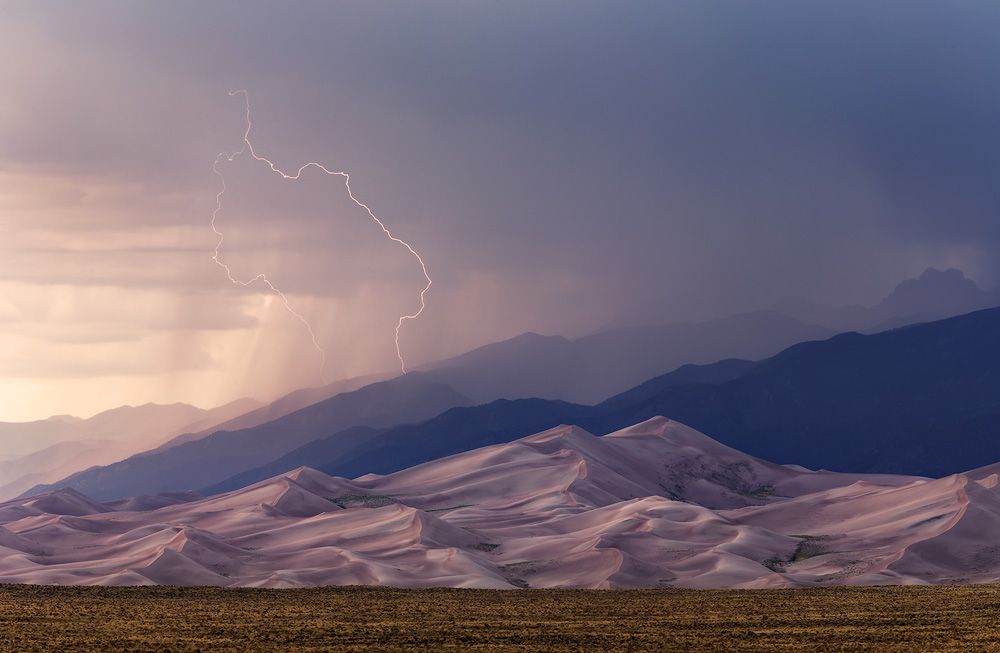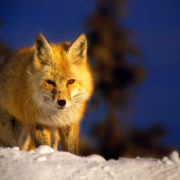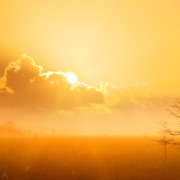What can Telephoto Lenses do for Landscape Photographers?
For the first half dozen years of my career as a landscape photographer I was completely, utterly, and unapologetically addicted to wide angle lenses. Like many landscape photographers influenced by the late, great Galen Rowell I was smitten by any photo that featured a punch-you-in-the-face foreground subject, compelling leading lines, huge mountains in the background, and a fiery sky to top it all off. I was so in love with this kind of photography that for a long time I virtually equated “wide angle photography” with “landscape photography.”
Over the past few years as I’ve let go of certain expectations and learned to explore all different kinds of opportunities I’ve found myself using telephoto lenses more and more for my landscape work. In fact, it’s fair to say that my telephoto has actually become my favorite lens for landscape photography. Now, I am as hopelessly addicted to it as I have been to my wide angle. Here are the reasons why.
Landscape photos are more personal
As a well-known landscape photographer said recently (and I’m paraphrasing): “wide angles leave very little to the imagination.” Wide angles by their very nature include a vast amount of the scene in front of you. This works wonderfully for creating an immersive, “feel like you’re there” experience for the viewer. Additionally, it tells them explicitly what the scene was like. Wide angles leave little room for imagination to ponder what’s happening just outside the frame, or how the photo fits into the larger environment. Often there’s little or no mystery to them. And to top it off, if you line up 8 photographers next to each other, all with wide angle lenses, you’re probably going to end up with 8 pretty similar photos, with maybe some small differences in framing and foreground choice.
Telephoto lenses by contrast only allow you to pick out a small vignette from the entire scene. It gives you an opportunity to say, “of all the things around me right now, this is what I want my viewer to know happened. This is what I want the viewer to look at.” It’s unlikely that another photographer will notice the exact same small vignette as you, which means that telephoto shots are often a more personal reflection of our vision of a scene.
In addition, the field of view of telephoto shots is so small it almost forces the viewer to contemplate the photo within the scene as a whole. What was going on outside the frame, or how does the photo fit into its environment? Without the explicit, obvious clues common to wide angle shots, images from telephoto lenses can create a deeper discussion and a deeper level of contemplation within the viewer.
Telephoto lenses pose more of a challenge
Now, I won’t say that wide angle landscape photography is easy. Far from it. In fact, to create a masterful wide angle shot requires as much compositional insight and creativity as you can muster. But to a certain extent, wide angle photography can be a little more forgiving. From a technical standpoint you have a little more leeway with your depth of field and focus. The very nature of wide angle photos gives them immense depth. Small changes to the composition still allow the overall photo to retain the same feel. And from an artistic standpoint they’re well-liked: as long as your photo hits the basic tick marks of foreground subject, leading lines, background subject, and pretty light in the sky, then it’s probably going to be a nice-looking image.
But everything about a telephoto requires you to be more precise and painstaking. If your focus and aperture aren’t spot-on it will be obvious in the final image. For example, a small change to the composition might cut off a critical element or allow too much dead space in the photo. Depth isn’t automatic; instead you have to work much more creatively to breathe depth into your photos by finding layering, contrasts, or atmosphere. And more often than not telephoto compositions don’t contain the same easy crutches as wide angle photos: no powerful foreground subjects and no vast sky filled with epic clouds mean you really must work the scene. All the interest in the photo comes from elements it contains and the way your composition aligns them. It’s a great challenge, and an extraordinarily satisfying one when you meet it.
Capture more unique landscape photos
There are few landscape photographers these days creating imagery with telephoto lenses. As I see it it’s an empty playground; most of the kids are busy having fun in the wide angle sandbox. And there’s absolutely nothing wrong with that. I still deeply love wide angle photography. However, if you are looking for a space where you can explore your photography without a lot of preconceived ideas about what’s possible, then telephoto landscapes are for you.
It’s a space where the photos aren’t obvious, where maybe you can make people stop and ponder a little more deeply, and where you can make images that are uniquely yours and yours alone.
Got any more reasons why landscape photographers would love shooting with telephoto lenses? Let me know in the comments!

















Having just shot Grand Canyon with an 80-300, this article really hit home with me. I have felt like a bit of an outsider to landscape shooters, since I have preferred tele compositions and pano landscapes, but now I know I’ve been on to something special for a long time! Thanks Josh !
How can you spend 700 days per year when a year has only 365 days???????
There are few photographers with landscape photography as stunningly beautiful as yours. These images made me gasp, and I am used to seeing 20 to100 wondrous shots per day. Thank you so much for this article.
I really enjoyed your words and images that illustrated it. Excellent work! Thanks a lot!
I found your article really interesting and I have to say I love your photographs. I have been using my 70-200mm lens for landscapes in the past but was wondering if it was the wrong thing to do as so many of the landscapes I view are taken with a wide angle lens with everything perfectly sharp and, as you say, leaving nothing to the imagination. You’ve given me the confidence to continue to experiment in this way. Thanks so much.
My experience is I shoot most of my landscapes with my 70-200mm zoom. Shooting primarily in the Blue Ridge and Great Smoky Mtns. of North Carolina, the stream filled, forested landscapes of these mountains lend them self to tight telephoto intimate landscapes.
Ha! Saw him present this at the Photo Expo at the Javitz Center in NY yesterday. Very good and made me think. :)
While I have found a majority of my shots were in the 20-50 range (using an 18-200 dx), I have just moved to a Tamron 18-400 to put on my D500. Many of my telephoto shots were ok, I was not getting the sharpest that I wanted. Hopefully this new lens will remedy that situation. Most of my picture taking is on travel/vacation/cruise events. My f-stops are usually between 5.6 and 11.
Quite interesting and inspirational, sir! I too, love wide-angle landscape work, but haven’t truly experimented with telephotos like the 90 or 55-200 zoom, in my case, Fujinon XF glass. You have inspired me to do so. Thank you! Regards, Steve
Do you ever find yourself in need of a fast f-stop for these kind of landscapes?
Not really. Most of the time my shooting is slow and deliberate. Usually I’m at f/8 or above. However I may open my aperture a bit if I’m shooting off tripod and need a little more shutter speed, say to capture the movement of a waterfall in the way I want.